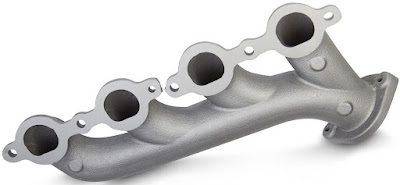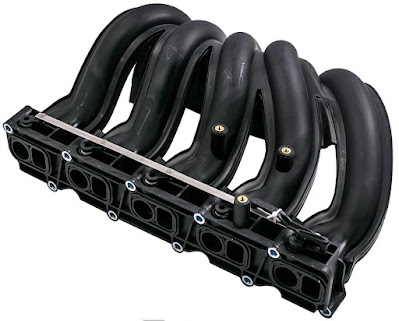14 Car Engine Components and Their Functions
Car Engine Components and Their Functions - The car engine consists of various components that are arranged into a single unit. These components work together so that the car engine can perform its functions properly.
Main Components of Car Engine (Engine System)
1. Static Machine Components
- Cylinder Head
- Cylinder Block
- Exhaust Manifold
- Intake Manifold
- Oil Pan
- Gasket
2. Machine Mechanical Components
- Pistons
- Connecting Rod
- Crankshaft
- Camshaft
- Timing Chain
- Valve
- Flywheel
14 Car Engine Components and Their Functions
1. Cylinder Head
The cylinder head functions as the top cylinder block, a place for the valve mechanism and the combustion chamber of an internal type engine.
The cylinder head must have high heat resistance, impact resistance considering its function as a place for the engine working mechanism.
On the cylinder head there are valve holes, intake, exhaust, spark plug holes, oil channels and the valve mechanism.
2. Cylinder Block
Cylinder block is the main part of a car engine with cylinder holes as a place for the piston to move translationally (back and forth) according to the working stroke of the motor.
Cylinder blocks are made of strong and thick materials such as cast iron. This material is strong and and has resistance to heat.
The construction and shape of the cylinder block is strongly influenced by the number of cylinders, cylinder arrangement, valve arrangement, type of valve mechanism used, and vehicle cooling system.
3. Cylinder
Cylinder is a part of a car engine that serves as a place for the piston to perform translational motion (back and forth) and transfer and form heat into mechanical energy.
Therefore, if you want your vehicle's engine to have maximum power, make sure there is no compression leak that may occur between the cylinder and piston.
4. Crankshaft
The crankshaft is the main component in the engine which functions to convert the translational motion of the piston into rotary motion (rotational motion) to then be channeled to the flywheel.
To maintain balance while the engine is working, the crankshaft is equipped with a balance weight. On this shaft there is also an oil channel for distributing lubricating oil to the journal crank bearings.
5. Camshaft
Camshaft serves to regulate the opening and closing of the valve with various mechanical intermediaries.
The shape or profile of the cam determines the point of movement, the speed of opening, closing the valve and the amount of lifting the valve from its seat.
6. Pistons
The piston has the function of receiving explosive power from the combustion process and transmitting the energy from the explosion to the crankshaft into rotational motion by means of the piston rod.
In addition to the above functions, the following are the functions of the piston which are closely related to the workings of the internal combustion engine:
- Sucking air into the cylinder
- Allows for compression
- Converting heat energy into mechanical energy
- Pushing the remaining combustion gases out
The process above is an event that occurs in the cylinder during the engine working stroke (2 stroke motor, 2 stroke or 4 stroke).
7. Connecting Rod
Connecting rod is a component of a car engine that serves to connect the piston to the crankshaft.
The main function of the connecting rod is to convert the reciprocating motion of the piston (translation) into rotary motion (rotation) on the crankshaft.
8. Piston Pin
The next engine component is the piston pin. This component serves to connect the piston with the small end of the connecting rod and to transmit the combustion pressure received by the piston to the piston rod.
9. Piston Rings
On the piston there are usually 3 rings which include 2 compression rings and 1 oil ring.
The function of the compression ring is as an adhesive between the piston and the cylinder wall. This will prevent compression leakage and prevent oil from entering the combustion chamber.
The function of the oil ring is to provide adequate lubrication to the cylinder walls when the engine is operating (under all conditions).
10. Valve
The valve is a component in a car engine that is mounted on the cylinder head.
There are two types of valves used in car engines, namely intake valves and exhaust valves. Considering the placement of the valve that is directly related to the combustion chamber, this valve is made of heat-resistant material that has strong durability and is rust-resistant (oxidation).
Valve Function
In Valve: Valve that regulates the entry of the air and fuel mixture into the cylinder
Ex valve: The valve that regulates the release of exhaust gases from combustion in the cylinder.
11. Oil Pan
The oil pan is used to hold vehicle engine oil.
The oil pan is located at the bottom of the cylinder block. Just like other parts through which fluids pass, the crankcase is also fitted with gaskets which function to avoid leaks in the vehicle engine.
12. Flywheel
The flywheel on a car engine has a function as a store of mechanical energy generated from the combustion process to keep the engine operating.
The moment of inertia resulting from this combustion process needs to be stored so that the performance of the engine remains stable and does not decrease. The flywheel is also a part that allows the vehicle to move when the starter is done.
13. Exhaust Manifold
The exhaust manifold has a function as a exhaust gas channel for combustion residues.
The residual combustion gas will be expelled through the exhaust manifold and then channeled through the car exhaust to reduce its heat and pressure before being discharged into the free air. This reduction process along the exhaust path will reduce the level of air and noise pollution. The high pressure difference will make a loud booming sound when the engine is operating. Therefore this pressure is reduced when passing through the exhaust system.
14. Intake Manifold
The function of the intake manifold is to become the inlet of fresh air before entering the cylinder chamber.
15. Gasket
Gaskets function for the connection of components through which the fluid is passed, whether it is fluid in the form of air or liquid.
The following are the 3 functions of gaskets used in car engines:
- Prevents leakage and maintains density
- Withstand pressure
- Distributing heat
The above are the main components of the car engine contained in the engine (drive) system. However, to perform its function properly, the vehicle requires other systems to support the performance of the vehicle engine which is divided into systems that have specific functions.
System Found on The Vehicle
1. Ignition System
Function: Burn the compressed air and fuel mixture in the cylinder chamber
2. Fuel System
Function: Supplying fuel needs from the tank so that it can enter the cylinder
3. Starter System
Function: As a prime mover, which moves the flywheel to then work on the Suction and Compression steps so that the engine can start.
4. Charging System
Function: Supplying electrical energy needs to the battery and the entire electrical system
5. Lubrication System
Function: Protects parts that rub against each other so as to minimize wear
6. Cooling System
Function: Keeps the vehicle in optimal working temperature and prevents overheating.
















Post a Comment for "14 Car Engine Components and Their Functions"